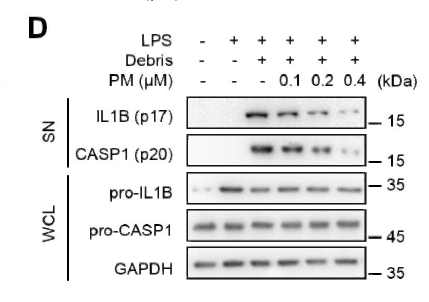Cleaved-Caspase-1 p20 (N120) Cell-Based Colorimetric ELISA Kit
- Catalog No.:KA3933C
- Applications:ELISA
- Reactivity:Human
- Gene Name:
- CASP1
- Protein Name:
- Caspase1
- Human Gene Id:
- 834
- Human Swiss Prot No:
- P29466
- Mouse Swiss Prot No:
- P29452
- Storage Stability:
- 2-8°C/6 months
- Other Name:
- Caspase-1 (CASP-1) (EC 3.4.22.36) (Interleukin-1 beta convertase) (IL-1BC) (Interleukin-1 beta-converting enzyme) (ICE) (IL-1 beta-converting enzyme) (p45) [Cleaved into: Caspase-1 subunit p20;Caspase-1 subunit p10]
- Detection Method:
- Colorimetric
- Background:
- alternative products:Additional isoforms seem to exist,catalytic activity:Strict requirement for an Asp residue at position P1 and has a preferred cleavage sequence of Tyr-Val-Ala-Asp-|-.,enzyme regulation:Specifically inhibited by the cowpox virus Crma protein.,function:Thiol protease that cleaves IL-1 beta between an Asp and an Ala, releasing the mature cytokine which is involved in a variety of inflammatory processes. Important for defense against pathogens. Cleaves and activates sterol regulatory element binding proteins (SREBPs). Can also promote apoptosis.,PTM:The two subunits are derived from the precursor sequence by an autocatalytic mechanism.,similarity:Belongs to the peptidase C14A family.,similarity:Contains 1 CARD domain.,subunit:Heterotetramer that consists of two anti-parallel arranged heterodimers, each one formed by a 20 kDa (p20) and a 10 kDa (p10) subunit. The p20 subunit can also form a heterodimer with the epsilon isoform which then has an inhibitory effect. May be a component of the inflammasome, a protein complex which also includes PYCARD, CARD8 and NALP2 and whose function would be the activation of proinflammatory caspases. Interacts with CARD17/INCA and CARD18.,tissue specificity:Expressed in larger amounts in spleen and lung. Detected in liver, heart, small intestine, colon, thymus, prostate, skeletal muscle, peripheral blood leukocytes, kidney and testis. No expression in the brain.,
- Function:
- response to hypoxia, regulation of cytokine production, positive regulation of cytokine production, proteolysis,apoptosis, induction of apoptosis, cell death, positive regulation of signal transduction, response to organic substance, regulation of protein kinase cascade, positive regulation of cell communication, positive regulation of protein kinase cascade, regulation of cell death, positive regulation of cell death, programmed cell death, induction of programmed cell death, death, protein processing, regulation of interleukin-1 alpha production, regulation of interleukin-1 beta production, regulation of interleukin-1 production, positive regulation of interleukin-1 alpha production, positive regulation of interleukin-1 beta production, positive regulation of interleukin-1 production,regulation of protein localization, response to ATP, regulation of apoptosis, positive regulation of ap
- Subcellular Location:
- Cytoplasm . Cell membrane .
- Expression:
- Expressed in larger amounts in spleen and lung. Detected in liver, heart, small intestine, colon, thymus, prostate, skeletal muscle, peripheral blood leukocytes, kidney and testis. No expression in the brain.
- June 19-2018
- WESTERN IMMUNOBLOTTING PROTOCOL
- June 19-2018
- IMMUNOHISTOCHEMISTRY-PARAFFIN PROTOCOL
- June 19-2018
- IMMUNOFLUORESCENCE PROTOCOL
- September 08-2020
- FLOW-CYTOMEYRT-PROTOCOL
- May 20-2022
- Cell-Based ELISA│解您多样本WB检测之困扰
- July 13-2018
- CELL-BASED-ELISA-PROTOCOL-FOR-ACETYL-PROTEIN
- July 13-2018
- CELL-BASED-ELISA-PROTOCOL-FOR-PHOSPHO-PROTEIN
- July 13-2018
- Antibody-FAQs


